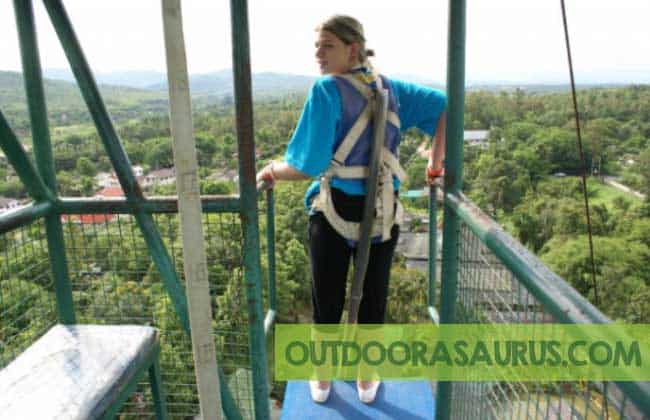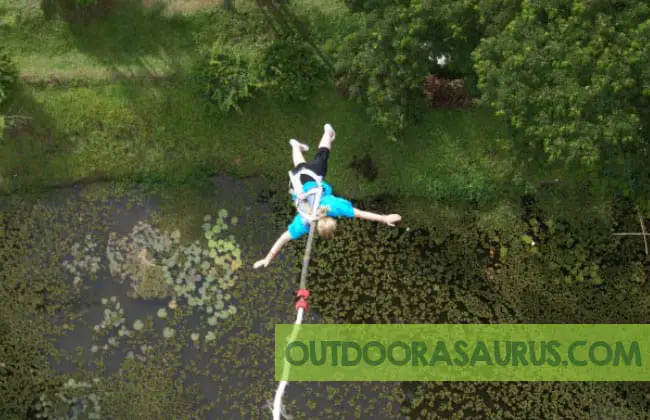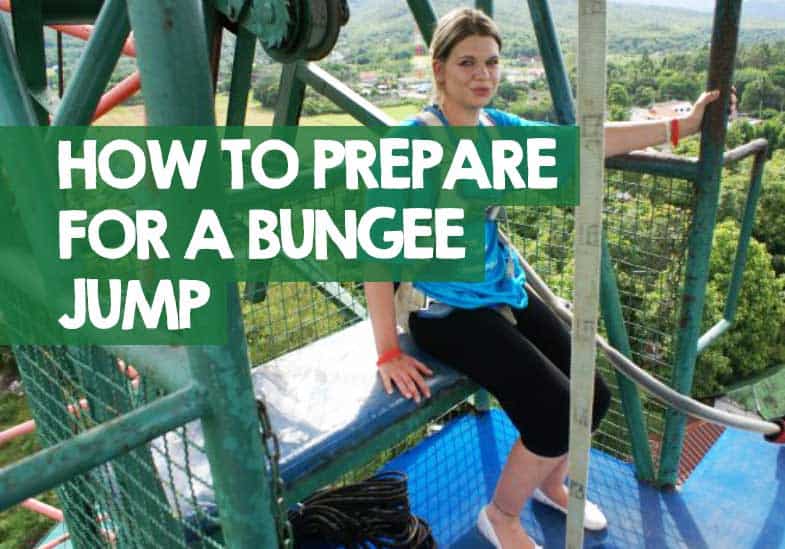First time bungee jumping can be a nerve-wracking experience. The fear of the unknown, whether the jump is safe, and how your body will react are going to be forefront of your mind. However, there are some things you can do which will make you better prepared.
My wife and I have bungee jumped in locations all over the world so decided to collaborate on this guide to bungee jumping tips for beginners which explain how you can be best prepared for your first-time jump.
The bottom line is; please don’t be scared. Many people have said it helped them with a fear of heights, and everyone we know who’s jumped has wanted to do it again.
I remember my first time very well. I was stood at the top of a platform in Thailand trying to look all calm and happy when the reality was very different. You see, I am petrified of heights. But the weird thing is, after my first bungee jump it’s not something that ever happened again with subsequent jumping.
Trust me, I think you will be the same!
Here’s how you can prepare for a bungee jump and then lower down the page I’ve included additional tips on what to wear and even some advice on how to jump better once you’ve got over your first experience.
How to prepare for your first bungee jump
1. Choose your jump operator and location carefully
My first tip is to choose your location. Why bungee jump off a crane over some ugly industrial area when you could be jumping into the void in an Amazonian jungle? Your first bungee jump could be a once in a lifetime experience (but you will want to do it again) so make the most of it and find a location that ticks all those Instagram wins!
Once you have your location set, research into the bungee company that runs the operation. In the wrong hands, bungee jumping can be fatal. Whilst deaths are very rare, there are some poor operators out there, particularly outside of Europe, New Zealand, and the United States.
Many countries will have strict legislation in place, but some none at all. You need to research the company to make sure they abide by sensible health and safety practices and have a track record that goes back years, not just a few months.

And it’s not just the company itself. I would also recommend you ask about the qualifications of the trainers and instructors before you book.
Put simply, don’t be afraid to ask any questions of the operator, no matter how silly they sound. Ask them about the staff and how they are trained. Ask them how long they have been operating for. Ask them what standards they work too and so on.
2. Assess your health and any injuries
All operators will have a list of existing medical conditions which will prohibit you from bungee jumping. You can see some of those below. However, you should also do your own due diligence on your health.
Bungee jumping is an exhilarating rush, so you need to be 100% certain your body and mind is in tip top condition before you go.
If you want to be completely prepared for bungee jumping, you might want to think about getting a medical check-up in advance.
If you have any of the following medical conditions you won’t be allowed to jump.
- Ankle or leg injuries: some bungee harnesses will be attached to your ankles and can put stress on an existing injury.
- Back, neck, or spinal injury injuries: don’t jump if you have any type of injury in these areas (including osteoporosis) as the pressure can be very painful, and even dangerous.
- Bone breaks, dislocations, or fractures: as with any injury, the pull on the bungee jump could be painful or make the injury worse.
- Epilepsy: the quick change in air pressure could trigger a seizure due to the brain’s oxygen levels being affected.
- Heart problems and conditions: no operators will let you jump with a heart condition including heart murmurs.
- High blood pressure: the excitement of a jump could increase your blood pressure to dangerous levels
- Pregnancy: the forces and falls could harm your unborn baby (read more).
One medical condition that some people say you can’t bungee jump with is asthma. However, this isn’t true unless you have been taking high dose steroid treatments. These can affect your bone density score, possibly leading to a fracture.
Some operators also won’t accept jumpers aged 65 or over, unless they have written permission from their doctor. Other operators recommend those over 50 get checked up before making a jump.
3. Do it with a friend or loved one
The best way to overcome any fears you have and prepare for your bungee is to do it with a friend or loved one. You can encourage and inspire each other to take the leap.
Plus, if you’re in it together, it’s going to be a lot harder to change your mind and back out… which relates very well to the next bungee jumping tip.
Handy Hint: A lot of people recommend a tandem bungee jump for their first time. I think this is a great shout as it means you’re facing each other and leap off on the same cord. You can read more about how tandem bungee jumping works here.
4. Book in advance so you don’t chicken out
If you have found the ideal bungee company and have the all clear to go, then get it booked as soon as you can.
When I took my first bungee jump, I booked months in advance and paid upfront. Not only did that mean I would find it harder to chicken out, but I also didn’t want to waste the non-returnable fee I had put down.
5. Don’t over think it
As the day of your first bungee jump gets closer it’s only natural to be anxious and possibly afraid… or you could be one of those people where excitement has taken over.
If you fall into the anxious category, then there are two schools of thought of how you can help to overcome the fear.
Most people will tell you not to over think it too much. They say that if you keep thinking through all the bad things that will happen, chances are you could back out of the bungee jump or be so ill-prepared that you don’t enjoy it.

Try to focus on different thoughts, take some deep breaths, and don’t let the nerves creep into your mind.
But then other people say you need to visualise success. This is what I did and how I overcame my fear of bungee jumping.
The method I used was to create a mental picture of me getting to the jump site, putting on the gear, going up in the lift, standing on the edge, and then jumping with no problems.
I tried to visualize myself being happy, calm, and serene.
6. Wear comfortable clothes and remove loose items
Depending on the weather and location you can either bungee jump barefoot or wear closed shoes. You should not wear slip on shoes as they will come off.
Recommended clothes would be trousers or shorts and don’t leave anything in your pockets. You will also be asked to remove your glasses, possibly your contact lenses, watch, and jewellery. If the jewellery is a stud, the operator may ask you to place a plaster or tape over it.
7. Tie up your hair
Loose and long hair is a no-no when bungee jumping. You will need to tie it back or up into a bun or ponytail to reduce the risks of hair strands getting caught in the cord.
Plus… who wants hair flapping in their face which could completely ruin the view you’re just about to experience!

8. Don’t overeat before hand
I once saw a guy vomit on a bungee jump. He puked on the way down, and then went back up through the puke on the first bounce. Not pretty.
The reason why? He’d had a full English breakfast of sausage, eggs, beans, and bacon all washed down with a cold Thai beer just one hour before his first bungee experience.
You can eat before bungee jumping though. In fact, you should eat something small at least. If you don’t, your empty stomach could make you feel dizzy during the jump. Just make sure it’s a tiny portion though, nothing too heavy, and a couple of hours before you go.
If you have a full stomach of food, with lots of liquid swilling around, you could throw it up just like that poor guy I saw in Thailand. Don’t be that guy.
Handy Hint: I also wrote an article about what bungee jumping feels like from start to end. It’s my own personal story and experience.
9. Prepare to get weighed
The staff will weigh you before you jump. They do this so they can calculate the cord lengths and calibrate the bungee jump to get the best experience as possible for you.
Often you will get weighed twice as an extra safety precaution. Take a look at this list of weight restrictions for bungee depending on where you are in the world.
10. Watch the briefing video
Most bungee operators will take you into a little room before the jump and show you a video of exactly how it’s going to work and what you need to do.
Listen to what they tell you and watch the video. By doing so you can get the most from the experience and will be as best prepared as you can possibly be.
11. Trust the equipment and instructors
You will now get led to the jump platform. You will be at your most nervous at this point, so put your trust and faith into the operators and the equipment you’re harnessed to. They will have done this process thousands of times with no accidents so you will be in safe hands.
You could also ask the instructor to say something to motivate you. Most bungee operators I have met are very good with nervous people and know just what to say to disarm your fears.
12. Try not to look down and fix your eyes on something
Don’t look down. This can set your fear off even more.
It will be hard to not be tempted to have a little peak, but if you’re really scared, don’t do it. Once you have jumped off the platform, you’re going to get plenty of opportunities to take in the view, so just put it off until then.

I find it also helps to fix your eyes on something static. It could be that you look at a point on the horizon, or if going off backwards you fix your eyes onto the bungee instructor.
13. Use calm breathing exercises
As you approach the edge of the jump platform, use some calm breathing exercises. This will help you to reduce anxiety, panic, and stress.
There is a great guide on the UK NHS website on how to relieve stress with calm breathing exercises (view the tips on NHS.uk). Here’s how to do it:
- Breathe deeply into your belly with long and slow inhales.
- Breathe in through your nose and then out of your mouth.
- On each inhale, count from 1 to 5.
- Don’t pause or keep your breath held in, but exhale slowing counting 1 to 5 again.
- Repeat the calm breathing for 3 to 5 minutes.
Handy Hint: If you are very nervous, start the breathing exercises 10 minutes before the jump. This will better prepare you for a bungee jump and will help calm nerves.
14. Clear your mind
The human brain is a complex organ and will react with fear when they future is unknown. You’ve never jumped from a platform before, so your brain can project a negative outcome back to you.
You need to clear your mind and switch off that little voice in your head. By doing so, you can enjoy the moment rather than dwelling on what the future holds.
This applies extremely well to bungee jumping and will prepare you for your first time.
15. Don’t try a fancy jump the first time
Most first-time jumpers won’t have any idea on how they are going to jump, and probably won’t give any thoughts on trying something fancy. You just want to survive right?
Don’t give any thoughts as to how you’re going to be jumping. Don’t over-complicate matters with planning something extravagant… you’ve got enough to be focusing on without muddling the process with a jump style.

Most bungee operators will offer a discounted price on a same-day second jump. Once you’ve got through your first experience, you can then attempt something a bit fancier the second time around.
Handy Hint: If you have jumped before and want to do a different jumping style, keep scrolling down for some different bungee jumping techniques.
16. Try to look into the camera and smile
At the end of your bungee jump you will have the opportunity to purchase photos and perhaps a video of your experience.
If you can (and I appreciate you might have other things on your mind), try to look into the camera and give a big smile as you leap down.
Alternatively, just scream and look absolutely petrified. Either will make for fun memories!
17. Don’t hesitate and just go for it!
Don’t hesitate, and just do it! You just don’t know when the opportunity will come again.

Related FAQs and tips
I hope that’s given you some insight on how to prepare for bungee jumping. Here are some commonly asked questions people will also ask before their first time jump.
What do you need for bungee jumping?
You don’t need anything for bungee jumping aside from yourself, comfortable clothes, and a sense for adventure.
If you are thinking about setting up a bungee jumping business, then there’s far too much to it to go into here. But at a basic level the equipment for a jump includes:
- Bungee cords: these are made from lots of long rubber strands that are wound and woven tightly together. Some will just make up one cord, whereas others are made from multiple cords wound together.
- Safety harness: there are two different harness types. Either a leg harness which is attached to the bungee cord, or one that harnesses to the body and is then secured to the ankle and then cord.
Can you eat before bungee jumping?
Yes, you can eat before bungee jumping. Around two hours before your jump have a light meal which is high in protein. Avoid heavy carbohydrates and lots of liquid.
What to wear bungee jumping?
You need to wear comfortable clothes when bungee jumping. I would also recommend that women don’t wear skirts or dresses for obvious reasons!
For footwear, wear shoes that are covered and lace up (no slip-ons). You can also jump with bare feet in warmer climates.
Can you wear contact lenses bunging jumping?
You can wear contact lenses when bungee jumping, but operators advise not wear to wear hard ones, only soft contact lenses.
I’ve got friends who have jumped with contact lenses on who have reported different experiences. One friend said he found it hard to open his eyes during the fall, the other friend had no problems at all.
What you might want to think about is buying a pair of goggles to wear over your eyes, so you can keep your contacts in – providing the bungee operator allows for this.
What happens after your first bungee jump?
You can expect to have adrenalin coursing through your body. It will be the most natural high you have ever experienced and it’s very possible you could be buzzing for up to a week afterwards.
I’ve never met anyone who hasn’t wanted to jump again straight after their first bungee!
Don’t forget to buy the photos and video so you can relive the experience!
Bungee jumping techniques
Once you’ve got your first-time bungee jump out the way you might want to try a few different jumping techniques on your next experience.
There is no real best way to bungee jump. It depends on what type of experience you want. Here’s 4 different bungee jumping styles you could pick from.
- The Swallow Dive: It looks just like is sounds. You leap off the platform with your arms outstretched from your sides letting you fly through the air and then down like a bird. As you fall and the cord stretches you will be turned upside down.
- The Back Dive: You stand with your back facing outwards, bend your knees, and then push off backwards, arching your back as you go.
- The Bat Drop: This is for experienced bungee jumpers only and will need an operator prepared to let you fall this way. You are hung upside down from the platform like a bat and then they let you go.
- The Elevator: You simply step off the jump platform with your feet pointing downwards.
Please Note: With all of these jumps there can be a risk of injury at the point you flip around to point the ground. They are for more experienced jumpers only and will be at the discretion of the operator.
Conclusion
Providing you have chosen a reputable company, all the safety precautions and expertise they have will mean you are in good hands. Nothing bad is going to happen and you are going to have the experience of a lifetime.
Once you are in the air you will get the most amazing feeling. For me it never actually feels like I am falling through the air, it’s more of a floating feeling.
When the bungee cord gets to its full length it won’t be a violent tug like you would expect, but quite a gentle swing.
Once you’ve completed your first jump, here’s how they get you back up or down again.
If you have enjoyed this article and went on to do your first ever jump, I would love to hear how you prepared for bungee jumping. Leave a comment below with your preparation tips and techniques.
You might also like…
I blog about bungee jumping every month. Here are some of my more recent articles about this awesome extreme sport:

